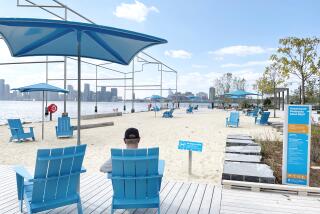Old N.Y. Waterfront Now Is for the Birds as Campaign for Sanctuary Takes Wing
- Share via
NEW YORK — Along Gowanus Bay in the Sunset Park section of Brooklyn, dilapidated, crumbling piers jut into the water, relics from the area’s booming shipping days. Empty warehouses loom like great walls sheltering the waterfront.
Amid the decay, life blooms in a shallow pool hugged by two sandbars, a landfill project never completed. In the last two years, 30 to 50 species of birds, including blue herons and egrets, have landed here to nest and feed.
“We think of it as a four-star restaurant for birds,” said Anthony Giordano, executive director of Sunset Park Restoration, a group lobbying to protect the habitat.
Birds migrating along the East Coast look for open spaces with shallow ponds and few people--exactly what Gowanus Bay and other New York sites offer them, said Kevin McGowan, curator of birds and mammals at the Cornell Laboratory of Ornithology.
The city waters often prove hazardous, though. Katharine Parsons, senior scientist at Manomet Bird Observatory in Massachusetts, said, “We are concerned about pollution everywhere in the New York harbor.” But she said places such as Gowanus Bay should be “protected and restored” to sustain bird life.
But the future of the Gowanus Bay habitat is uncertain. The discovery of the habitat comes just as the community struggles to revitalize the waterfront.
The latest and most significant effort came in late February, when the Southwest Brooklyn Industrial Development Corp. petitioned the state to declare the entire 80-acre Bush Terminal area an Economic Development Zone. If created, the zone would lure businesses with tax and utility incentives.
It could also ignite an intense debate between birders and businesses. “The downturn in business in the last few years has actually been good for the birds,” Giordano said, adding that his group wants the habitat mapped as a wetland.
Giordano said people can’t see the habitat on current maps, which represent the area as industrial.
No one saw it at all until an extensive, $125,000 city study on Bush Terminal in 1991.
“Originally, we thought it would make a nice industrial site,” Giordano said. “But then we saw it had been reclaimed by nature.”
James Sparkman, economic development director for the southwest Brooklyn industrial group, said he supports the idea of a bird sanctuary, but added, “I’m concerned about the implications of a wetlands on business development in the area. There’s a real potential for development there.”
Sparkman, whose office at the waterfront and 43rd Street overlooks the bird habitat, said he’s not sure how far Giordano wants to go to protect the birds, but there could be conflict if there is “a real plan to develop the area.”
It is unclear when any plans will be solidified. Last October, the city declared Bush Terminal an “industrial green park,” reserved for recycling businesses, but 70% of the sites remain vacant.
Rep. Jerrold Nadler, whose district includes the area, plans to introduce legislation to study the feasibility of turning the terminal into a cargo port.
His plans may stall, however, with news of the habitat. An aide to Nadler in Brooklyn, Brad Korn, said he became aware of the bird haven only recently. “It is something we will have to take into account. We have to protect our wildlife.”
Giordano, whose group conducted its own study of the habitat this year, said, “The amazing thing is that it’s the only natural habitat for birds from the Verrazano all the way to the Brooklyn Bridge.”
And so every Thursday morning for a year and a half, a member of Sunset Park Restoration has been at the water’s edge conducting a bird census to be shared with the Manomet observatory. Several endangered and threatened species have been seen, including the state-threatened commontern.
Although it may seem odd for birds to flock to such an industrial area, McGowan stressed that it’s not, and that the habitat is worth protecting. “Some of the best birding I’ve done has been with some really horrible stuff in the background.”
More to Read
Sign up for Essential California
The most important California stories and recommendations in your inbox every morning.
You may occasionally receive promotional content from the Los Angeles Times.













